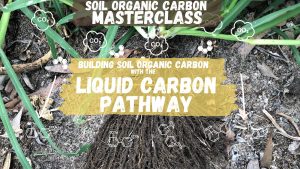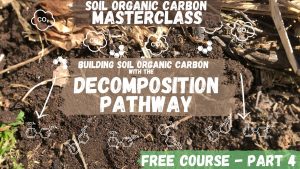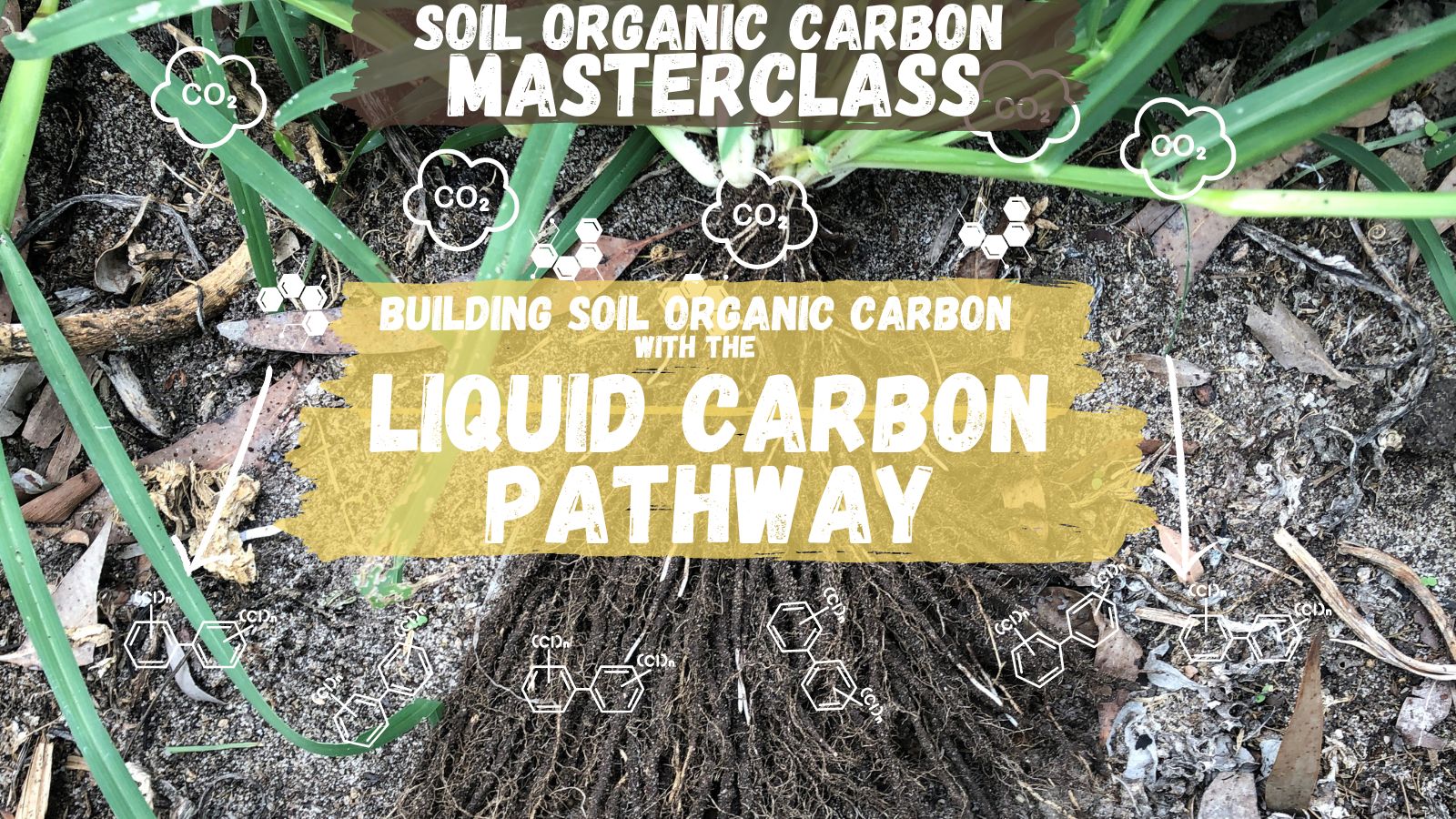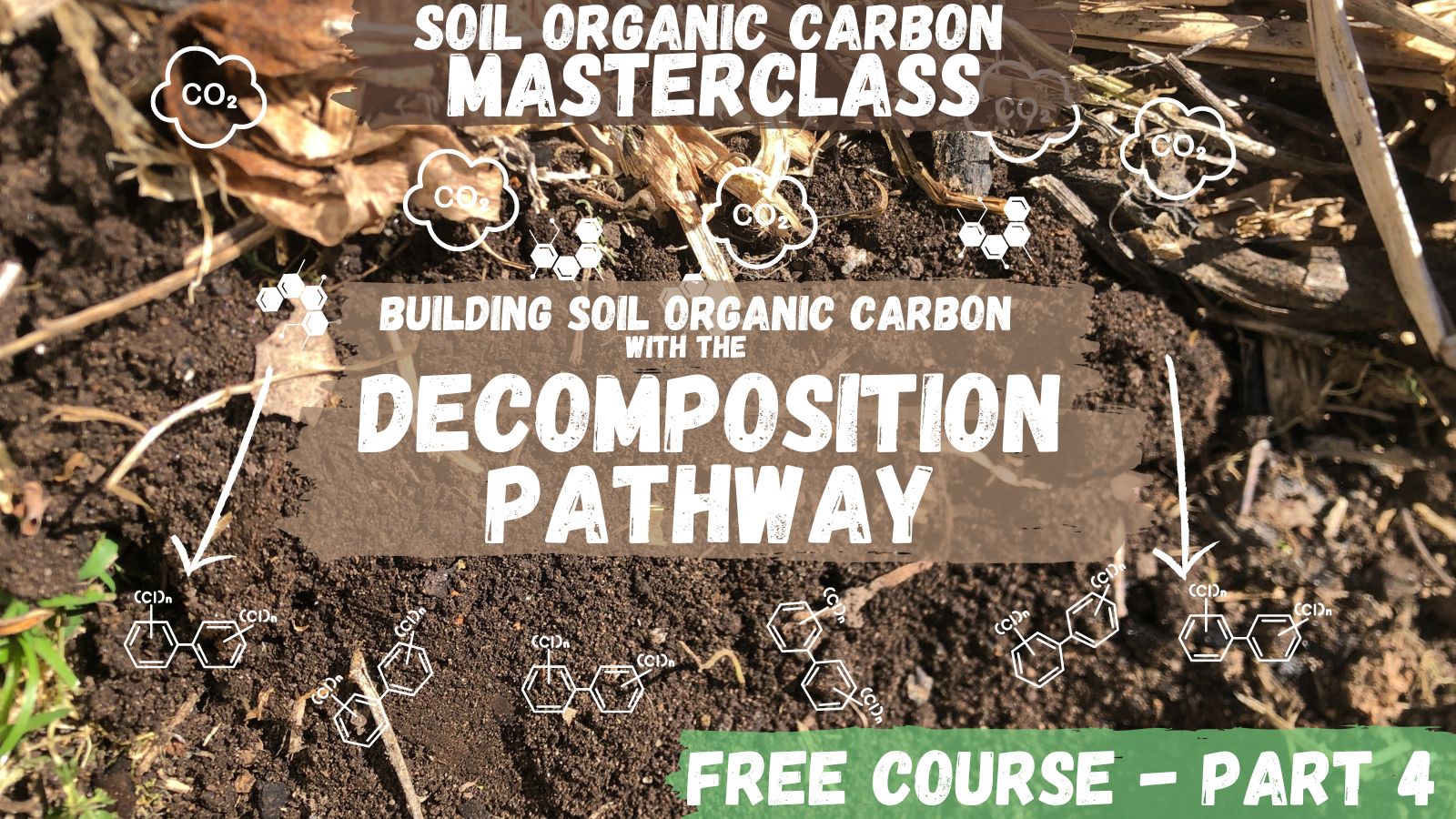The benefits of Soil Organic Carbon allow for us to ultimately improve our soils to better grow plants. In this lesson of the Soil Organic Carbon Course we discuss all the benefits of soil organic carbon including the physical, chemical, biological and financial benefits.
First watch the video and then read the supplementary material for more information.
Missed the first lesson? Check out Introduction To Soil Organic Carbon
Key Lessons:
- Soil Organic Carbon makes our soils ideal for growing plants.
- Physical Benefits include: Aggregation, Water holding and a reduction in evaporation.
- Chemical Benefits include increased CEC and AEC, pH and Eh balancing, chelation, water bridging and buffering of toxins.
- Biological Benefits include: Energy for Microbes, Suppressing diseases, biological transmutation, increased germination and seedling growth, root growth and photosynthesis.
- Soil organic carbon increases fertiliser use efficiency.
- All of this contributes to financial benefits from increasing soil carbon by increasing yield and reducing inputs.
What Does Good Soil look like?
Before we discuss the benefits we gain from increasing Soil Organic Carbon, lets first outline the favourable characteristics of a healthy soil:
- Well-Structured Aggregates: Good soil typically has well-formed aggregates, which are clusters of soil particles bound together by organic matter, microbial byproducts, and root exudates. These aggregates create pore spaces that allow for proper aeration, water infiltration, and root penetration. This is important for increasing the usable zone within our soil profile and effectively providing our plants with “more soil”. Having well-structured soil sures that water can rapidly move into the soil and prevent any sideways runoff.
- High Water Holding Capacities: It is important for our soils to hold sufficient levels of water to ensure our plants are hydrated. Soils that are able to hold more water can sustain higher levels of crop production and yield, or extend the period before going into drought.
- Nutrient Status: The nutrient status of the soil is important to supply the soil with adequate minerals to allow for growth, development and reproduction. Soils with a high capacity to hold and exchange nutrients are capable of carrying greater crop production.
- Lack Of Limitations: Ideally, we need soils that aren’t going to hinder crop production. This can include extreme pH (too acidic or basic), salinity issues, sodicity problems and compaction.
- High Soil Biota Activity: The soil biota (everything living within the soil) are capable of many functions that improve crop production and further improve soil health. Some functions include aggregate stability and formation, residue decomposition, disease suppression, nutrient availability and supplying plants with growth hormones and autoinducers.
All of these soil features support plant production, and more importantly, are benefits that we can gain from increasing soil organic carbon. A great example of the benefits we gain from increasing soil organic carbon can be found visually in the image below.
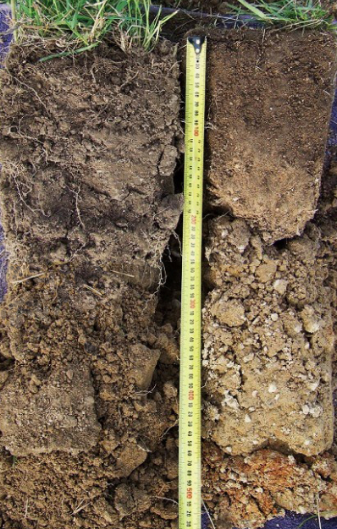
Soil Carbon Comparison
This is a great example of the effects of soil organic matter on soil characteristics. These two soil profiles were taken on neighbouring farms with the same soil type and climate, except that one farmer was using regenerative practices while the other wasn't. On the left side is a regenerative soil with 3.79% organic matter while the right side has only 2.24% organic matter. Notice how dark and aggregated the soil is further into the profile. Moreover, roots can be seen at the very bottom of the profile. The soil on the left is building soil organic carbon throughout the profile while the soil on the right isn't.
In terms of benefits gained, the left side has significantly greater levels of soil aggregation to a greater depth which would allow for all the benefits above.
Physical Benefits Of Soil Organic Carbon
Soil Organic Matter contributes to three main physical characteristics, these include:
Soil Structure
Soil structure is the way our soil particles group together. If they all group together into one solid piece, then the soil would have a “massive” structure, likewise soil can have weak or no structure if they do no group together. Poorly structured soil limits water infiltration, gas exchange and reduce root expansion. Ideally, we want well structured soil meaning the soil groups together into aggregates of a few centimeters. This allows for large amounts of pore space between the soil aggregates, resulting in increasing water infiltration, gas exchange and root expansion. Having water, air and roots deeper into the soil profile allows the plant to have more access to water and nutrition. As seen in the side-by-side soil comparison above, the right hand side has well aggregated soils throughout the soil profile while the left soil seems massively structured at the top of the soil profile, followed by some structure but then stopped with a potential compaction layer. Moreover, it is interesting to see mottling (patches of coloured soil) at the bottom of the soil profile which would suggest water is not effectively moving through that layer resulting in some anaerobic areas.
Water Holding Capacity
This is one of the most important components of our soil and ultimately drives a lot of our soil’s production capabilities. The Water holding capacity is the soil’s ability to hold water. In addition that that the Plant Available Water Capacity is the amount of water held by the soil that used by the plant. This is due to an increase in energy required to absorb water as the water dries out.
Soil Organic Carbon is able to hold 7 times it’s weight in plant available water, likewise soil organic matter can hold 4 times it’s water. This can massively improve our ability to hold and supply more water to our plants. The following table shows how much additional water you could hold in the top 30cm of soil for every increase in soil organic carbon:

Plant available water capacity is very dependent on soil texture where in the same 30cm of soil the following textures would hold the following amount of water:
- Sand – 15mm
- Sandy Loam to Clay Loam – 24mm to 36mm
- Heavy Clay – 45mm to 60mm
Therefore, when considering increases to plant available water, an increase of 2% points in soil carbon can almost double your soil’s plant available water capacity in the top 30cm of soil.
If we were to put a financial value to this increase, the GRDC estimate that for every 1mm of additional water you store after a fallow period, you can expect an 8kg increase in wheat yield per hectare. This means that a 2% increase in SOC would hold an additional 58.8mm of water resulting in an additional 470kg wheat yield!
If wheat sold for $400 a tonne then that would produce an additional $188 in income. Considering a lot of the costs are fixed at this point, much of this would become profit.
Soil Temperature
Soil Organic Matter also has the ability to buffer soil temperature, this means that the soil stays cooler during summer and warmer during the winter. This is important for reducing evaporation as evaporation is dependent of temperature, and improving sowing conditions after winter. Improved conditions after winter can largely be contributed to increased microbial activity resulting in slightly warmer soils. Although, it is very difficult to determine exactly how much soil carbon buffers soil temperatures, it still remains an important aspect of the overall benefits soil carbon contributes to the functioning of the soil.
Chemical Benefits Of Soil Organic Carbon
The chemical benefits that the soil gain from soil carbon ultimately drive a more fertile soil environment, the ways that soil carbon contribute to this include:
Cation and Anion Exchange Capacity
Soil organic carbon contains both positive and negative charges that allow the compound to hold cations (Positively charged minerals, e.g Ca+2, Mg+2, K+, Na+, NH4+, etc) and anions (Negatively charged minerals, e.g NO3-, SO4-2 and H2BO3-, etc). Soil organic carbon typically hold between 100 to 300 cmol of cations for every kilogram of soil carbon. In contrast, some of the best clays have a CEC that range from 120 to 150 cmol/kg.
Because soil organic matter also has areas of positive charge, it is also capable of holding onto negatively charged nutrients. This is different to most clays were they only contain negative charges meaning they can only hold positively charged nutrients.
By increasing a soil’s carbon component, soils can capture and hold more nutrients available for plant uptake. This means less nutrients leached and a higher fertile soil.
pH and Eh Buffering
pH (Acidity and Alkalinity) is the measure of protons (H+) concentration in a solution. In soil science, this is proton concentration of the soil solution and is very important for determining nutrient availability and biological activity. Soil organic matter has the ability to resistant the change in pH (this is called buffering) to balance the soil pH near the optimal pH of 6-7. This is done the soil organic matter acting like a sponge to absorb excess amounts of protons, hence moving the pH towards neutral.
Similar but different to pH is Eh (or redox potential. i.e reduction and oxidation), this is the potential for the soil to exchange single electrons (e-). Simply, pH is H+ where as Eh is e-. Redox is very important for determining nutrient availability, especially in the trace minerals. For example, iron (Fe) can exist as Fe+2 (Reduced) or Fe+3 (Oxidised), however plants can only absorb the reduced form of iron (Fe+2). Soil organic matter has the ability to absorb excess e- (poising) to ensure balance. This is very important for ensure trace minerals are available for plant uptake.
Buffering Toxins
Soil organic matter provides an important function in assisting with the buffering of toxins, such as pesticides, herbicides and antibiotics. This is done through two main processes:
Supplying Microbes with Energy: Soil organic matter can be used as an energy source for microbes that can carry out the function to breakdown toxins.
Capturing the Toxin inside Soil Organic Matter: Some toxins that aren’t able to breakdown can be captured inside the structure of soil organic matter preventing them from harming microbes or plants.
Nutrient Chelation
Plants can often have difficulties absorbing some nutrients, specifically metals. Chelation is the process where these metals bond to other compounds to improve their ability to be absorbed by the plant. Soil organic matter specifically fulvic and humic acid are effective chelators that can increase the uptake of most metals by forming a humate. Some of these metals include Zinc, Iron, Nickel, Manganese and Copper.
Water Bridging
Water bridging is when water in the soil is joined to two or more soil particles. This is important for the movement of soluble nutrients as a continuous path of water is needed to move towards the root. Soil organic matter can increase the water bridging ability of the soil and therefore increase the movement of nutrients towards the root.
Biological Benefits Of Soil Organic Carbon
Soil organic carbon also brings many biological benefits to the soil, these include:
- Energy Source For Microbes: Soil organic carbon, mainly labile carbon, can be used by microbes as a energy source. This supports both microbial activity and populations. Greater biological activity in the soil increases the soil’s functionality such as decomposition, nutrient availability, aggregation, disease suppression and water availability through symbiotic relationships.
- Suppressing Pathogen Enzymes: Soil organic carbon can contribute towards a disease suppressive soil by capturing, stabilising and deactivating pathogen enzymes. As pathogens attack plants, they release enzymes to degrade the root cell walls to allow for pathogen entry. However, soil organic carbon can intersect the pathogen enzymes before they reach and degrade the plant roots.
- Biological Transmutation: This is a process where soil microbes can convert one element into another, for example, Sodium into Potassium. Soil Organic matter assists in this process by supplying microbes with sufficient amounts of energy to conduct transmutation. This has important applications in sodic soils where sodium is in excess.
- Germination and Seedling Growth: The application of humic substances have been found to increase germination time and numbers as well as seedling growth rates and vigourness. This is most likely due to the plant utilising the humic substance as an energy source and supplying addition minerals. Therefore, soils high in humic soil organic matter and contribute to a strong and fast growing plant.
- Root Growth: The application of humic substances to plants were found to increase root growth by 30% to 50%. Soil rich in soil organic matter as humus could support larger plant root systems which would assist the plant in larger amounts of available water and nutrients.
- Chlorophyll and ATP Content: The foliar application of humic substances were found to increase the concentration of leaf chlorophyll and ATP. This would result in a greater photosynthetic capacity and allow for the transfer of energy by greater levels of ATP available.
- Plant Energy: Plants are able to absorb humic substances as a source of energy, this contributes to greater plant energy levels. Moreover, the chelation and availability of amino acids and sugars as a nitrogen source reduces the plant energy output to uptake and convert nutrients into suitable forms. This allows for the plant to greater energy levels for growth and development.
Fertiliser Use Efficiency
Soil organic carbon can also improve fertiliser use-efficiency through two main functions:
- Reduced Leaching: Due to soil organic matter having a higher CEC and AEC, leaching can be significantly reduced when soil organic carbon levels are increased. In addition to this, some studies suggest that the addition of a carbon component (like compost) to fertiliser application can reduce leaching by up to 30%. This is mostly important for nitrogen and sulfur as these nutrients are easily leached from the soil.
- Increased Uptake: The addition of humic substances to a foliar application was found to increase NPK uptake between 100% to 500%. This is due to the humic substance signaling to the plant to increase leaf permeability, therefore allow for more nutrients to move into the leaf.
Financial Benefits Of Soil Organic Carbon
You can’t be green if you’re in the red! So it always important to consider the financial costs and benefits of a practice. Understanding the financial benefit of increasing soil organic carbon can allow us to start calculating how much we are willing to spend in order to increase soil organic carbon. There key areas that we can make money by increasing soil organic carbon include:
- Increased Nutrient Availability and Reduced Fertiliser inputs: From increasing CEC and AEC, buffering pH, chelating minerals, reducing leaching and increasing foliar efficiency, we can easily assume that the nutrient status of the soil is going to be greater and when we apply fertiliser, that nutrition is going to have a greater uptake and efficiency then otherwise.
- Increased Plant Available Water: As discussed above, a 2% soil organic carbon increase results in an increase of 58.8mm of water in the top 30cm of soil. This is a massive opportunity for increased production as for every additional 1mm of water we gain 8kg of wheat yield per hectare. This is likely to be the biggest benefit from increasing soil organic carbon as much of this will largely move straight into profit.
Although many of the other benefits would assist in increasing yields or reducing pesticide costs, it is every difficult to determine a dollar figure on this, so for the calculations below, we will just be considering an increase of fertiliser use efficiency of 30% and an increase of 58.8mm of water from a 2% soil carbon increase.
The following figures is for a 3.5 tonne wheat crop using some figures from GRDC.
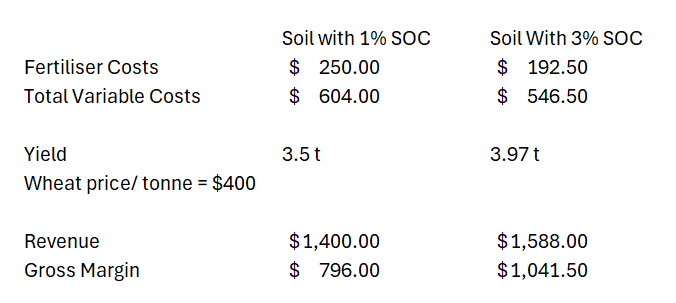
Here is the breakdown for the figures above:
- A 30% increase in fertiliser efficiency would reduce in a 23% reduction in fertiliser inputs (as we can apply less if we get more about of it). This would cause our fertiliser costs to go from $250 to $192.50.
- We are going to assume that all our other variable costs stay the same, i.e pesticides, sowing costs, etc.
- The additional 58.8mm of water is going to increase wheat yields by 470kg/ha therefore increasing yields from 3.5t to 3.97t.
- This results in a $188.50 increase in revenue.
- However, since most of our costs are fixed at this point, most of that money becomes gross profit. This increases our gross profit by 30% with only a 13.4% increase in revenue.
Although these numbers are very rough, it helps to see the potential financial benefit gained from increasing soil organic matter. If the benefit gained is an additional $245.50 in profit, then we can assess the costs required to increase soil organic carbon to these levels. This could include cover crop seed, inoculates, etc.
Carbon Credits (ACCUs)
Carbon credits are units of 1 tonne carbon dioxide offset. Meaning that if you offset or sequester 1 tonne of carbon dioxide, you could make one ACCU. ACCUs could provide additional financial benefits as these ACCUs could be sold to companies that we emitting carbon dioxide in order for their emissions to be offset, and therefore the company becomes “Carbon Neutral”. Building soil organic carbon is one way that ACCUs could be made, there is the math of what it could look like:
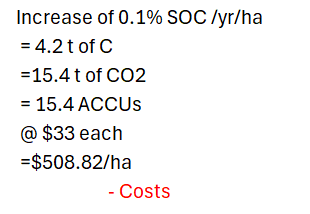
In the calculation above, we consider a 0.1% increase in soil organic carbon in the top 30cm of soil. This would result in $508.82/ha/yr of carbon credits. It is important to note that this is BEFORE costs, and there are lots of costs. Some costs include the baselining of the farm, soil samples, administration costs and the costs require the build the soil carbon (such as cover crop seed, biochar, potential yield reductions, fertilisers, etc).
Although Agresol does not assist in setting farmers up on carbon credit programs, we can consult on the agronomics of building soil carbon, so if the numbers above got your interest, we offer a free coaching call to get your on the right track, if that sounds like you, you can find our application form HERE.




